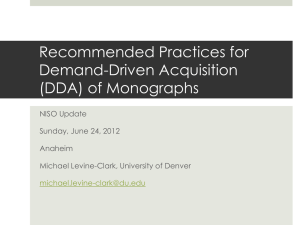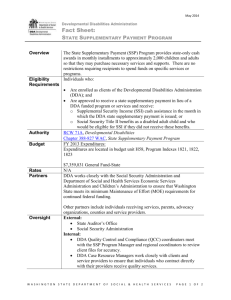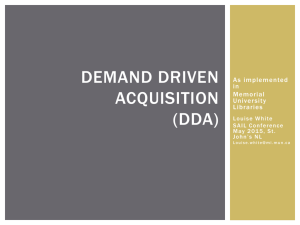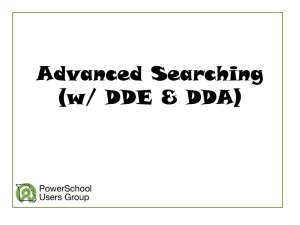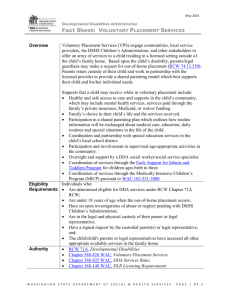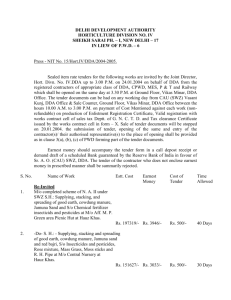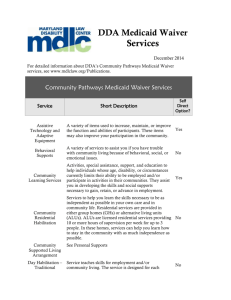Best Practices for Demand-Driven Acquisition of Monographs
advertisement
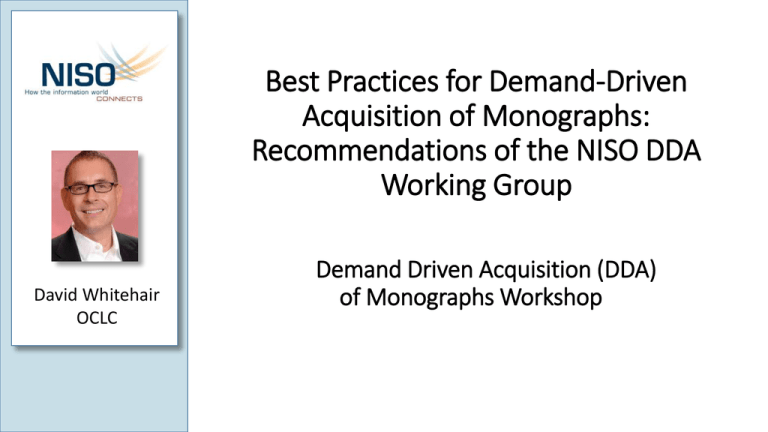
Best Practices for Demand-Driven Acquisition of Monographs: Recommendations of the NISO DDA Working Group David Whitehair OCLC Demand Driven Acquisition (DDA) of Monographs Workshop http://www.niso.org/publications/rp/rp-20-2014 Goals • Develop a flexible model for DDA that works for publishers, vendors, aggregators, and libraries • Model should allow for DDA programs that • • • • Meet local budget and collection needs Allow for consortial participation Support cross-aggregator implementation Account for how DDA impacts all functional areas of the library Committee members • Lenny Allen Oxford University Press • Stephen Bosch University of Arizona • Scott Bourns JSTOR • Karin Byström Uppsala University • Terry Ehling Project Muse • Barbara Kawecki YBP Library Services • Lorraine Keelan Palgrave Macmillan • Michael Levine-Clark University of Denver • Rochelle Logan Douglas County Libraries • Lisa Mackinder University of California, Irvine • Norm Medeiros Haverford College • Lisa Nachtigall Wiley • Kari Paulson ProQuest • Cory Polonetsky Elsevier • Jason Price SCELC • Dana Sharvit Ex Libris • David Whitehair OCLC BACKGROUND What is DDA? Demand-driven acquisition (DDA) is acquisition of library materials based on patron use at the point of need Why DDA? • DDA allows libraries to provide users with immediate access to a wide range of titles to be purchased at the point of need • Libraries have embraced DDA because it has the potential to rebalance the collection away from possible use toward immediate need Terms • Consideration pool All of the books available for potential purchase within a library’s DDA program • Discovery record A MARC record supplied to a library by a supplier/vendor to enable discovery of a title within the consideration pool • Free discovery A feature of some DDA models that provides free access to an e-book before a trigger occurs • Short-term loan (STL) A lease of an e-book for a brief period within a DDA program Terms • Auto-purchase Within a DDA program, a purchase by the library of perpetual access to an e-book based on usage by patron • Trigger Any event within a DDA program that causes a financial transaction to occur • Point-of-purchase record A MARC record loaded by a library after purchase of a title via a DDA program; intended to be used permanently • Delete file A set of discover records or record IDs generated to match titles no longer available in a library’s consideration pool, and used to remove records from a library’s catalog and discovery tools KEY ASPECTS OF DDA Sustainability • Libraries • Large amount of content to users without risk of overspending budgets • Pricing levels and triggers defined so that normal discovery and use can run throughout the year • Publishers • Pricing model set at a level to maintain revenue and continue to publish books • Long run could damage the scholarly communication ecosystem Free Discovery • Early DDA programs resulted in buying large numbers of un-needed books and overspending budgets • Free discovery ensures that most uses of a book that trigger financial transaction are substantial and meaningful Temporary Lease • Short-term lease (STL) allows library to pay for a single use for a fraction of the cost of purchasing the book outright • Library savings if title is used a handful of times • May not be sustainable for publishers over time Purchase • All programs offer option to purchase • Preference is to purchase most heavily used materials • Libraries have varying aims; point at which purchase occurs should be flexible Alternative Models • DDA with free discovery, STLs, and purchase based on triggers requires sophisticated technical systems • Evidence-based acquisition (EBA) • Publisher provides access to titles for set period of time • Library agrees to pay set sum for perpetual access • Library selects titles at end of period based on usage data • Also known as evidence-based selection (EBS) or usage-driven acquisition (UDA) GOALS AND OBJECTIVES Breadth of the Program • Why are you creating the program? • Primary means of building monographic collections • Supplement to existing practices • Contributes to size of pool of titles, number of suppliers to use, size of budget, etc. Access vs. Ownership • Ownership goal: • Purchase titles early in usage cycle • In general, more expensive, but have permanent access • Broad access goal: • Purchase titles late in usage cycle or not at all • In general, less expensive, access to more titles, but low perpetual access CHOOSING PARAMETERS Triggers and Transactions • Automatic financial transactions • STLs and auto-purchases • Evidence-based acquisition • Reach end of agreed upon time period and spending pre-negotiated amount of money • Loan Periods for STLs • One-day, one-week, one-month loans Suppliers • Commercial aggregator • More titles from wide range of publishers • Not necessarily all titles from a publisher • Generally more restrictive digital rights management (DRM) • University Press aggregator • Similar to commercial aggregator in breadth of content across a range of publishers • Closer to publisher platforms in terms of DRM and less automated DDA processes Suppliers • Publisher • Often access to more content than via aggregators • Generally less DRM • Not yet designed to manage unmediated DDA, so choosing evidence-based acquisitions model • Approval vendor • Integration with and de-dup against broader book approval plan • Profile at more nuanced level • Manage plan and de-dup across multiple aggregators PROFILING Profiling Considerations • Ensure pool of adequate size relative to budget and user base • Subject and non-subject parameters • Relationship to print • Retrospective titles MANAGING MARC RECORDS MARC Records • Discovery Records • Customization and enrichment • Discoverability • Library catalog/OPAC, Discovery tool, Shared/consortial catalog • Point-of-purchase records • At time a purchased title is invoiced • Can include acquisitions data to generate ILS order records and support electronic invoicing REMOVING MATERIALS Reasons for Removing Materials • Collection development choices • Subject, currency, availability of new edition, duplication with print, price increase, etc. • Financial risk • Reduce pool if budget cannot keep up with demand • Publisher • Pulled from aggregator • Stopped offering via DDA Recommendations 1. Establishing Goals • Four broad goals for DDA • • • • Saving money Spending the same amount of money more wisely Providing broader access Building a permanent collection via patron input Saving Money • Providing access to fewer books • Emphasizing temporary access (STLs) over perpetual access (purchasing) • In evidence-based programs, having a higher usage threshold prior to purchase Spending Same Amount More Wisely • Larger pool of titles, emphasis on temporary access • Smaller pool of titles, emphasis on perpetual access Providing Broader Access • Most expansive pool possible • Emphasizing STLs over perpetual access • In evidence-based programs, having a higher usage threshold prior to purchase Building a Permanent Collection via Patron Input • Having a tightly-focused profile/smaller consideration pool • Emphasizing perpetual access over STLs • In evidence-based programs, having a lower usage threshold prior to purchase 2. Choosing Content to Make Available • Important Issues • Not all p-books available as e-books • No single supplier provides all e-books • Not all e-books available via DDA or under same models • Therefore • More comprehensive coverage requires more suppliers and more models • Broadest coverage possible = include print • Approval vendors can help manage DDA across multiple suppliers • Publishers should recognize that libraries may wish to limit number of suppliers, and plan accordingly 3. Choosing DDA Models Mix of auto-purchase and STL based on goals of program • Auto-Purchase • Purchase triggered on the first use longer than free browse • Purchase triggered after set number of uses • Purchase triggered after set number of STLs • STL • A set number of STLs prior to auto-purchase • Only STLs, with no auto-purchase 3. Choosing DDA Models • Evidence-based acquisition • Sometimes only option based on platform capabilities • Library and publisher should develop expectations based on analysis of past usage • Publishers may wish to participate in some or all models • Some concern by publishers about sustainability of STL 4. Profiling • DDA profiles should be based on the broadest definitions possible within these areas, and relative to goals of the program • Subject coverage should provide access to a wide range of content, even in subjects that may not be core • Retrospective coverage for critical mass • Especially in programs that otherwise limit coverage • May or may not overlap with print holdings, depending on library preference 5. Loading Records Libraries should: • • • • • Load records regularly and as soon after receipt as possible Load records into as many discovery tools as possible Code records for easy suppression or removal Enrich metadata to increase discoverability Load point-of-purchase records after purchase to ease acquisitions workflow/payment 6. Removing Content Libraries should: • Remove records from all discovery tools as soon as feasible, often using supplier’s delete file • Establish regular cycle for removal • Maintain a record of titles removed for assessment 7. Assessment • There are multiple reasons for assessment, so this should be planned from the start • • • • • Measuring overall effectiveness of the program Measuring success at cost reduction Measuring usage Predicting future spending Managing the consideration pool • Data sources might include • COUNTER reports • Vendor/publisher supplied reports • ILS or other local data 8. Preservation Libraries and publishers should work together to ensure that un-owned content remains available, perhaps in partnership with third-party solutions such as LOCKSS and Portico. 9. Consortial DDA Three basic models: • Multiplier (a multiple of list price allows shared ownership) • Limited Use (shared ownership, but with a cap on use before a second copy purchased) • Buying Club (shared access to consideration pool, but individual ownership) 10. Public Library DDA • Mediated • Wish lists • Often not through the catalog Recommended Practice Demand Driven Acquisitions of Monographs: http://www.niso.org/publications/rp/rp-20-2014 Survey results: http://www.niso.org/apps/group_public/download .php/12541/DDA_Survey_Results.pdf Thank you! David Whitehair OCLC whitehad@oclc.org
